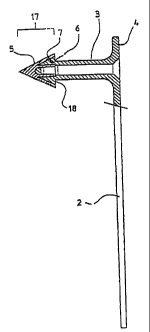Some of the information on this Web page has been provided by external sources. The Government of Canada is not responsible for the accuracy, reliability or currency of the information supplied by external sources. Users wishing to rely upon this information should consult directly with the source of the information. Content provided by external sources is not subject to official languages, privacy and accessibility requirements.
Any discrepancies in the text and image of the Claims and Abstract are due to differing posting times. Text of the Claims and Abstract are posted:
| (12) Patent: | (11) CA 2236077 |
|---|---|
| (54) English Title: | AN ANIMAL EAR TAG |
| (54) French Title: | ETIQUETTE D'OREILLE POUR ANIMAL |
| Status: | Deemed expired |
| (51) International Patent Classification (IPC): |
|
|---|---|
| (72) Inventors : |
|
| (73) Owners : |
|
| (71) Applicants : |
|
| (74) Agent: | NORTON ROSE FULBRIGHT CANADA LLP/S.E.N.C.R.L., S.R.L. |
| (74) Associate agent: | |
| (45) Issued: | 2006-05-16 |
| (86) PCT Filing Date: | 1996-07-12 |
| (87) Open to Public Inspection: | 1997-01-30 |
| Examination requested: | 2003-01-28 |
| Availability of licence: | N/A |
| (25) Language of filing: | English |
| Patent Cooperation Treaty (PCT): | Yes |
|---|---|
| (86) PCT Filing Number: | PCT/NZ1996/000074 |
| (87) International Publication Number: | WO1997/002739 |
| (85) National Entry: | 1998-04-28 |
| (30) Application Priority Data: | ||||||
|---|---|---|---|---|---|---|
|
An animal ear tag having a male component (1) including a main body portion
(2),
a neck portion (3) extending from the main body portion (2) and a tip portion
(5) for
engagement with a female component (20). The distal end of the neck portion
(3) from
the body portion (2) provides a base (7) for the tip portion (5). The tip
portion (5) is of
pyramidal shape with at least three upper edges converging at the apex. The
tip portion
(5) comprises hollow areas between an internal core and two opposite pyramidal
faces into
which corresponding protrusions of the base (7) of the neck portion (3)
interlock.
Etiquette d'oreille pour animal, possédant une pièce mâle (1) constituée d'une partie formant corps principal (2), d'une partie intermédiaire (3) s'étendant à partir du corps principal (2), et d'une partie formant pointe (5) adaptée pour s'emboîter dans une pièce femelle (20). L'extrémité distale de la partie intermédiaire (3), par rapport au corps principal (2), constitue un support (7) pour la partie formant pointe (5). La partie formant pointe (5) est de forme pyramidale et présente au moins trois arêtes supérieures qui sont convergentes au niveau du sommet. Ladite partie formant pointe (5) comporte des zones creuses comprises entre une âme interne et deux faces pyramidales opposées, et dans lesquelles s'emboîtent des saillies de forme correspondante prévues sur le support (7) de la partie intermédiaire (3).
Note: Claims are shown in the official language in which they were submitted.
Note: Descriptions are shown in the official language in which they were submitted.

For a clearer understanding of the status of the application/patent presented on this page, the site Disclaimer , as well as the definitions for Patent , Administrative Status , Maintenance Fee and Payment History should be consulted.
| Title | Date |
|---|---|
| Forecasted Issue Date | 2006-05-16 |
| (86) PCT Filing Date | 1996-07-12 |
| (87) PCT Publication Date | 1997-01-30 |
| (85) National Entry | 1998-04-28 |
| Examination Requested | 2003-01-28 |
| (45) Issued | 2006-05-16 |
| Deemed Expired | 2008-07-14 |
There is no abandonment history.
| Fee Type | Anniversary Year | Due Date | Amount Paid | Paid Date |
|---|---|---|---|---|
| Application Fee | $150.00 | 1998-04-28 | ||
| Maintenance Fee - Application - New Act | 2 | 1998-07-13 | $50.00 | 1998-04-28 |
| Registration of a document - section 124 | $100.00 | 1998-07-22 | ||
| Maintenance Fee - Application - New Act | 3 | 1999-07-12 | $100.00 | 1999-06-29 |
| Maintenance Fee - Application - New Act | 4 | 2000-07-12 | $100.00 | 2000-06-23 |
| Maintenance Fee - Application - New Act | 5 | 2001-07-12 | $150.00 | 2001-06-27 |
| Maintenance Fee - Application - New Act | 6 | 2002-07-12 | $150.00 | 2002-07-02 |
| Request for Examination | $400.00 | 2003-01-28 | ||
| Maintenance Fee - Application - New Act | 7 | 2003-07-14 | $150.00 | 2003-06-23 |
| Maintenance Fee - Application - New Act | 8 | 2004-07-12 | $200.00 | 2004-06-23 |
| Maintenance Fee - Application - New Act | 9 | 2005-07-12 | $200.00 | 2005-06-16 |
| Final Fee | $300.00 | 2006-02-28 | ||
| Expired 2019 - Corrective payment/Section 78.6 | $200.00 | 2006-05-12 | ||
| Maintenance Fee - Patent - New Act | 10 | 2006-07-12 | $250.00 | 2006-06-27 |
Note: Records showing the ownership history in alphabetical order.
| Current Owners on Record |
|---|
| MICHAEL STUART GARDNER |
| Past Owners on Record |
|---|
| BLADEN, ROY VICTOR |
| GARDNER, MICHAEL STUART |